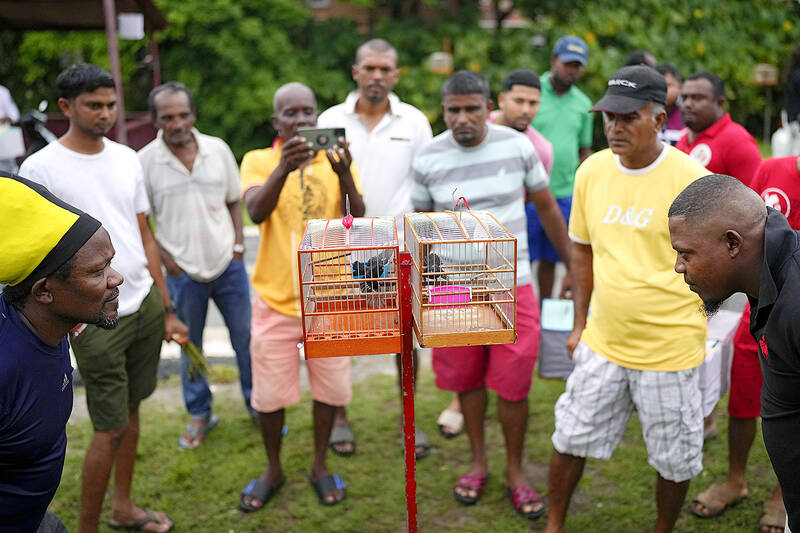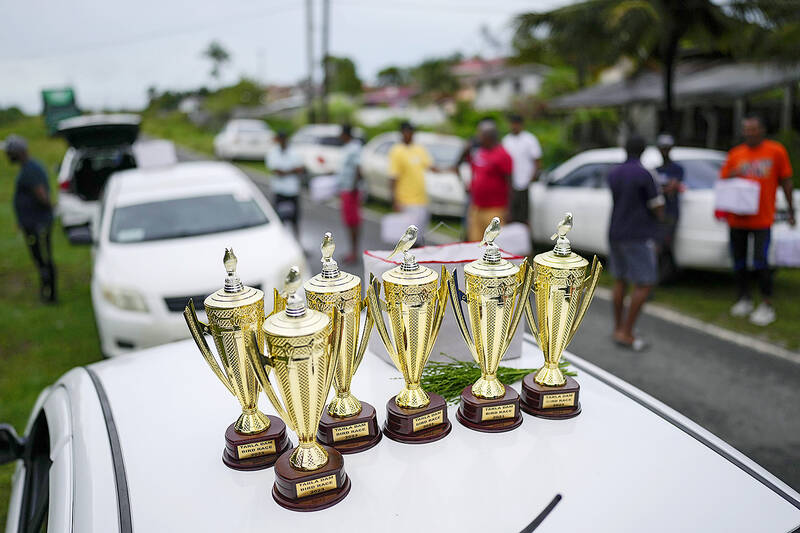The judges leaned in, hands clasped behind their backs.
Everyone grew quiet as they stared at the two tiny black birds flitting before them, wondering which one would break the silence.
“One. Two,” a judge called out softly as the bird on the right erupted into tinkly chirps. It then abruptly stopped as the bird in the cage next to it darted about before bursting into song, only to be surpassed seconds later by his foe, which spread its wings and tail in anticipated triumph.

Photo: AP
These are Guyana’s speed-singing contests — a centuries-old tradition where male finches are placed in cages next to each other as judges count the number of chirps they emit in the span of five minutes. It’s a hobby and business that rakes in thousands of dollars and is expected to grow into an even bigger gambling operation given the recent massive oil discovery off the coast of this small South American country, whose economy is expected to grow by an average annual rate of 25 percent in upcoming years.
The races are held every Sunday across the country, with men gathering along roadsides at dawn with their caged birds and local beer to celebrate or mourn afterward.
“God. Family. Birds. That’s my life,” said Olwayn Lynch, a 46-year-old transportation business owner.

Photos: AP
The races are closely scrutinized given the money involved, so people record them for replay in case someone feels a judge counted too many or too little chirps and demands a recount.
There’s also big money in selling these finches: Average singers go for around US$75, while winners can cost up to US$10,000. The demand for these birds is so high that they are often smuggled to places like New York, where the Guyanese diaspora also organizes races. Smugglers have tucked finches into hair curlers, toilet paper rolls, pantyhose and other items. Some even wear special pants to carry them through airport security.
Demand in Guyana has grown even higher since oil production began in 2019, with more people competing, said Ben Winston, 59, who sells bundles of wild grass seeds at the events.

Photo: AP
“More people, more bets, more fun,” he said, adding that he has seen his business grow about 2 percent and hopes it will become even more profitable as the oil wealth flows, creating more jobs and expendable income.
‘PROFESSIONAL ATHLETES’
In the weeks leading up to a race, owners care for their birds like professional athletes, giving them vitamins, calcium and wild seeds mixed with honey. If they are molting, the birds don’t compete because their energy levels plummet when shedding feathers. The races also are not for birds that are easily excitable or get shy in front of a crowd. The winning bird has poise, bravado and grit. They don’t sing for pleasure or because they’re happy: they sing to defend their territory or attract mates.
Sunday’s race attracted a smaller crowd than usual given the heavy skies and recent rains. Among those attending but not competing was Ryan Boodhoo, a 42-year-old importer and contractor, who felt the birds present were not as competitive as he would like.
Boodhoo estimates he has won more than 1,000 races since he began participating 25 years ago: “For me, it’s not just competing. It’s like my therapy.”
He recalled how at 6 years old, he stole someone’s bird from the roadside, mesmerized by its song. Hours later, his aunt forced him to return it and punished him by rubbing a spicy ointment in his eyes, but his love for birds remained. He now has more than 40 distributed between his home and those of friends.
“The tone that the bird makes is sweet. It’s very comforting to my ears,” he said.
When the birds are not competing against each other on Sundays, they accompany owners in their daily lives: perched in street market stalls, nestled in the passenger seat of taxi cabs or hung in wooden boats that cross the long Demerara River just west of the capital of Georgetown.
“I like the whistling. It keeps me company,” said Trevor Fort, 55, who sells face masks and do-rags at Georgetown’s bustling Stabroek Market, where his bird recently chirped above the cacophony of car horns, reggae music and vendors hawking their wares like auctioneers as the sweet smell of ganja wafted into the heady air.
Fort was gifted his first bird at 8 years old and caught his first one at age 13 after spending up to three hours “in the bushes just hiding and waiting until we see the bird done come.”
Like many, he mixed sugar with a bit of sticky tree sap and placed it on a stick to lure the bird. Others use nets, breed them in captivity or buy from street market vendors who purchase them from Amerindians who catch the birds in Guyana’s remote interior or people who smuggle them in from neighboring Venezuela.
By age 15, Fort was entering competitions. He has since dropped out of races to attend church on Sundays, but he cares for his 10 birds as if they were still in competition mode.
Like other owners, he’ll play them downloaded recordings of other birds singing for up to four hours a day, making sure to first cover their cages with a light cotton material so they can focus on the melody without distractions.
“It’s like training a baby. It’s going to listen to what you say,” he said.
LENIENT ACCEPTANCE
The best singer is the large-billed seed finch, Sporophila crassirostris, known locally as a “twa-twa” and considered expensive and rare. The second-best singer is the chestnut-bellied seed finch, Sporophila angolensis, or “towa-towa.” There’s also the plumbeous seedeater, Sporophila plumbea, or “mountain canary,” which is cheaper and as a result, more available, according to a December 2018 bird trafficking report by Traffic, a wildlife trade monitoring network. For local birders, the premier chirp is the one that sounds like “pee-peeow.”
While Guyana’s Wildlife Division allows people to legally trade the three birds with an annual cap of 200 per species, local authorities “maintain a lenient acceptance of local bird markets,” the report stated, noting that bird races have generated an “unsustainable demand” for the best singers.
“Trapped almost to extinction in Guyana and Suriname, they go completely unnoticed in other Amazon countries,” the report said of the birds. “As the population that usually buys these birds is in the low-income sector, these species make for cheap presents and continue the customary practice of keeping of birds in homes and backyards.”
Some birds are sold at Stabroek Market, where Paul Lall, 72, sat in a dark corner stall reading a newspaper on a recent morning while birds in cages hovered above him and cockroaches scurried beneath his feet as he waited for customers. He has sold birds for more than 50 years, and said owners take good care of them because they’re considered pets.
And the better you treat them, the better they sing, Lall said, noting that people also take the birds on walks or hire people to do so.
The races and sales of birds are a boon for those struggling to get by in this country of some 800,000 people, of which an estimated one-third live in poverty. Orin Bradford, a 30-year-old minibus driver, said he sells his birds only if his bank account shrinks.
“Birds are business!” he said with a wide smile, showing a sliver of a gold tooth. “Sometimes when the funds are low, we use them to rise back up.”
While songbirds are hugely popular in Guyana, not everyone is a fan. For years, Henry Ochore, 35, has tried to persuade his friends to release their finches to no avail until he convinced one last week.
“I don’t like them caged up,” he said. “It’s not good.”

June 23 to June 29 After capturing the walled city of Hsinchu on June 22, 1895, the Japanese hoped to quickly push south and seize control of Taiwan’s entire west coast — but their advance was stalled for more than a month. Not only did local Hakka fighters continue to cause them headaches, resistance forces even attempted to retake the city three times. “We had planned to occupy Anping (Tainan) and Takao (Kaohsiung) as soon as possible, but ever since we took Hsinchu, nearby bandits proclaiming to be ‘righteous people’ (義民) have been destroying train tracks and electrical cables, and gathering in villages

Dr. Y. Tony Yang, Associate Dean of Health Policy and Population Science at George Washington University, argued last week in a piece for the Taipei Times about former president Ma Ying-jeou (馬英九) leading a student delegation to the People’s Republic of China (PRC) that, “The real question is not whether Ma’s visit helps or hurts Taiwan — it is why Taiwan lacks a sophisticated, multi-track approach to one of the most complex geopolitical relationships in the world” (“Ma’s Visit, DPP’s Blind Spot,” June 18, page 8). Yang contends that the Democratic Progressive Party (DPP) has a blind spot: “By treating any

Swooping low over the banks of a Nile River tributary, an aid flight run by retired American military officers released a stream of food-stuffed sacks over a town emptied by fighting in South Sudan, a country wracked by conflict. Last week’s air drop was the latest in a controversial development — private contracting firms led by former US intelligence officers and military veterans delivering aid to some of the world’s deadliest conflict zones, in operations organized with governments that are combatants in the conflicts. The moves are roiling the global aid community, which warns of a more militarized, politicized and profit-seeking trend

This year will go down in the history books. Taiwan faces enormous turmoil and uncertainty in the coming months. Which political parties are in a good position to handle big changes? All of the main parties are beset with challenges. Taking stock, this column examined the Taiwan People’s Party (TPP) (“Huang Kuo-chang’s choking the life out of the TPP,” May 28, page 12), the Democratic Progressive Party (DPP) (“Challenges amid choppy waters for the DPP,” June 14, page 12) and the Chinese Nationalist Party (KMT) (“KMT struggles to seize opportunities as ‘interesting times’ loom,” June 20, page 11). Times like these can